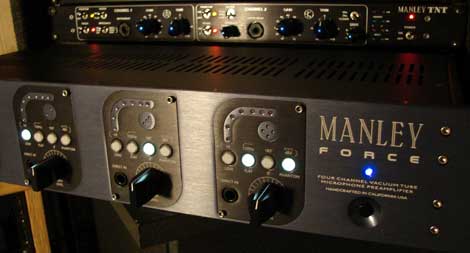Originally Posted By Rob Tavaglione for ProSoundNetwork 05.27.2015
On the heels of Manley Labs’ successful launch of its Core input channel, the company delivers another anticipated success, the Force Four-Channel Microphone Preamplifier. And no surprises here—this preamp is a winner.
Features
Not unlike its Core, Manley’s Force relies on the company’s usual Class A topologies, tubes and transformers for tone. Here’s the full feature set: http://www.manley.com/mfrc.php. Design highlights include an all-new power supply, 300 VDC rails, dual-triode 12AX7 tubes, the exact same DI utilized in the Core, and Manley custom-wound transformers.
In Use
Upon powering up, the Force clicks a few relays and goes into 30 seconds of slow warm-up. Once its blue light completes its flashing sequence, it’s ready for business. The HPF, phantom power and gain range switches are relay-switched and nicely illuminated.
As a fond user of the Manley TNT mic amp (featuring both solid-state and tube channels), I can say that the Force has its own signature sound rather similar to my TNT’s tube side, yet actually closer to the Core in overall tone. The Force is the opposite of soft, slow, gritty and/or dark; it is notably fast, crisp, dynamic and high fidelity. Its tube and transformers do not impart so much color or grit as they do smoothness, grace and euphony.
For best results, I found that using the low-gain range cranked up sounded cleaner and most desirable; if users need more than 50 dB of gain there are internal jumpers to reach 60 dB. I ran the Force wide open at +50 dB for some mandolin and guitar overdubs and it actually sounded nice—there was no top-of-range noise or nastiness.
On vocals I found the Force’s response to be right on point, producing an overall sound that was mostly linear, but bathed in a certain “hi-fi” sparkle that, for lack of a better description, sounds “expensive.” Long story short, results were very similar with all the sources I amped via the Force: always clean, pretty and never the slightest bit veiled, slow or murky.
Compared to the Core, the DI sounds identical but the Core has an overall more plump, velvety and “cushion-y” sound that I believe to be color from the optical compressor. The Force’s DI input sounds really nice, with definite midrange emphasis, and non-linear, in a good way. With it, my Telecaster sounded okay; my passive bass sounded very warm, all punchy and classy; and my active Kubicki bass sounded absolutely killer, as if it had been gently processed into ideal musicality.
With drums—kick, snare and stereo overheads—I found that tube overdrive really wasn’t a possibility, but who cares? The Force’s excellent imaging, silky smooth sparkle, open dynamics and ability to grab some low frequency kick drum decay (even from an itty-bitty 16-inch diameter kick) earned praise from both guest drummer Stacy Huggins and myself. Stacy called the Force “faithful,” and I concur. Please check out this all-Force drum tracking webclip: www.soundcloud.com/pro-audio-review-magazine
Summary

